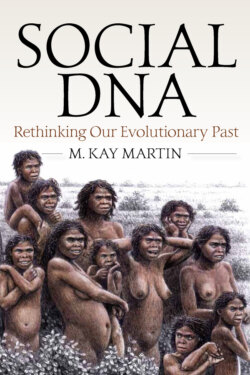Читать книгу Social DNA - M. Kay Martin - Страница 20
На сайте Литреса книга снята с продажи.
Reproductive Roles and Social Origins Theory
ОглавлениеBefore the development of modern genetic science, theorists speculating on the evolution of early human sociality relied principally on observations of animal reproductive behavior, along with conclusions drawn from their own cultural experience (including sacred creation myths). The prevailing Victorian viewpoint was that perceived differences in male-female sexuality were linked to innate behavioral traits. Males were naturally sexual, aggressive, competitive, and cognitively superior. Females, in contrast, were both defined and limited by their maternal reproductive functions. As such, they were typically characterized as naturally asexual, passive, nurturing, noncompetitive, and also less capable of complex thought. Several nineteenth-century scholars proposed that these disparate male and female traits had consequences for the way that human society evolved. The abbreviated version of such theories is that, thanks to the alleged sexual restraint of women, early humans emerged from an original state of promiscuity to one of ancient matriarchy, in which society was organized around the obvious biological linkage between females and their offspring. This evolutionary stage was eventually overthrown by males, who established domestic units and enjoyed sociopolitical dominance from that point forward.2
Hindsight being 20/20, such notions about innate male and female aptitudes and universal evolutionary stages are now typically dismissed as examples of both gender stereotyping and immature science. But as with the story of the egg and the sperm, cultural bias continues to color our perception of human nature and societal origins. Although presented with a different veneer, behavioral stereotypes rooted in the perceived consequences of anisogamy have been amazingly persistent. International conferences and symposia held in the late 1950s and 1960s framed a model of ancient Paleolithic social life that equated the advent of hunting by males with the origin of human culture itself. As in Victorian times, males were portrayed as sexually dominant and competitive, but as presumably bridling this enthusiasm for the camaraderie of the hunt. This model assigned males active roles as family heads and providers to dependent consorts and offspring, and credited them with the defining achievements in human evolution, such as the invention of tool making.3 Females, in contrast, were cast in a largely peripheral role, serving as reproductive vessels and performing perfunctory domestic tasks of limited economic value. They were, in essence, silent partners in the evolutionary saga—dependents and nonproducers who traded sexual favors and reproductive functions for economic support.4
A subsequent spin-off of this model, the male-bonding hypothesis, gained some popularity in the early 1970s.5 Its basic thesis was that males are biologically predisposed toward cooperative activities, whereas females lack such built-in genetic codes. Proponents argued that this sexual divide originated from selective pressures that favored bonding among males, initially for group defense and eventually for the predation of the hunt. The model went further, linking such activities to cortical expansion in ancient humans—a consequence of subordinating male sexual competition to the interpersonal cooperation and emotional control necessitated by cooperative hunting. Opportunities for social and intellectual advancement provided by the hunt were allegedly unavailable to the other half of the species due to their reproductive responsibilities and assumed temperament. Females, allegedly burdened by serial pregnancies, inferior physical and cognitive abilities, and swings in “emotional tonus,” were not only presumed unfit for the hunt, but to pose a disruptive influence by stimulating male competition for sex. On this basis, the theory concluded that natural selection has favored females who acquiesce to their basic reproductive and domestic roles.
A new chapter on theories of human social origins was introduced in 1975 with the publication of E. O. Wilson’s Sociobiology. The sociobiology movement spurred significant new scientific research that has led to a re-examination of assumptions about the evolutionary consequences of human anisogamy. Unanimity of opinion among its followers, however, has been elusive.6 One sociobiological perspective, exemplified by the selfish-gene theory, is that the disparate reproductive strategies of the sexes are inherently conflicting and are played out in an atmosphere of male self-interest, parasitism, and deceit. Other sociobiological theories, in contrast, recognize differences in male-female reproductive strategies but seek to understand how the fitness of both sexes and that of group members is facilitated through the evolution of social behaviors based on cooperative, reciprocal relationships. These contrasting viewpoints are briefly outlined here, and their relevance for theories on human family origins are explored more fully in the next two chapters.
